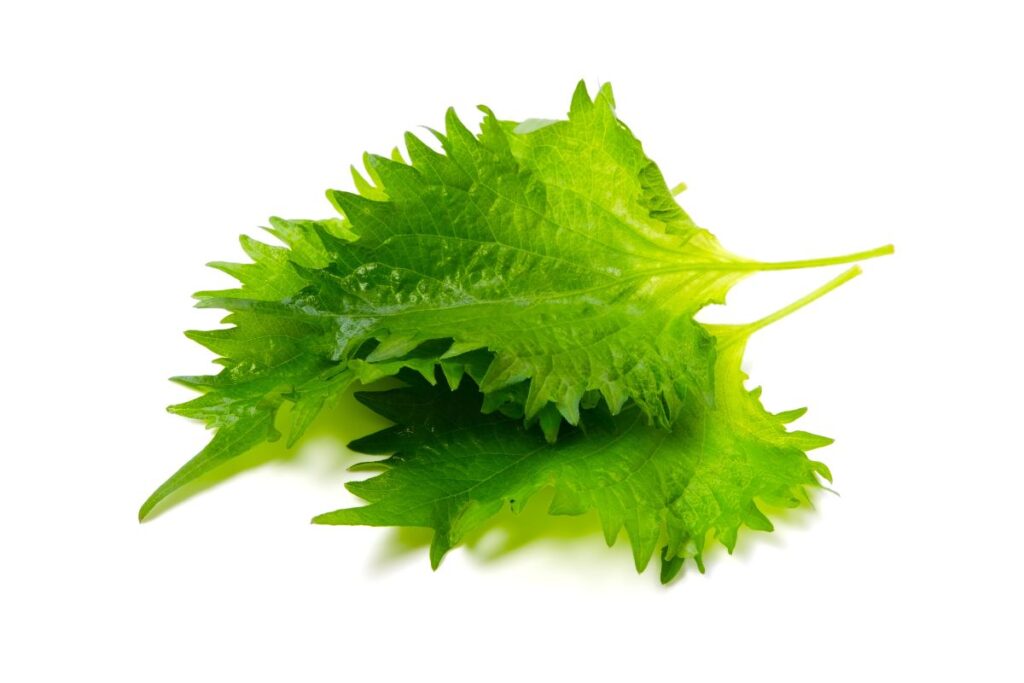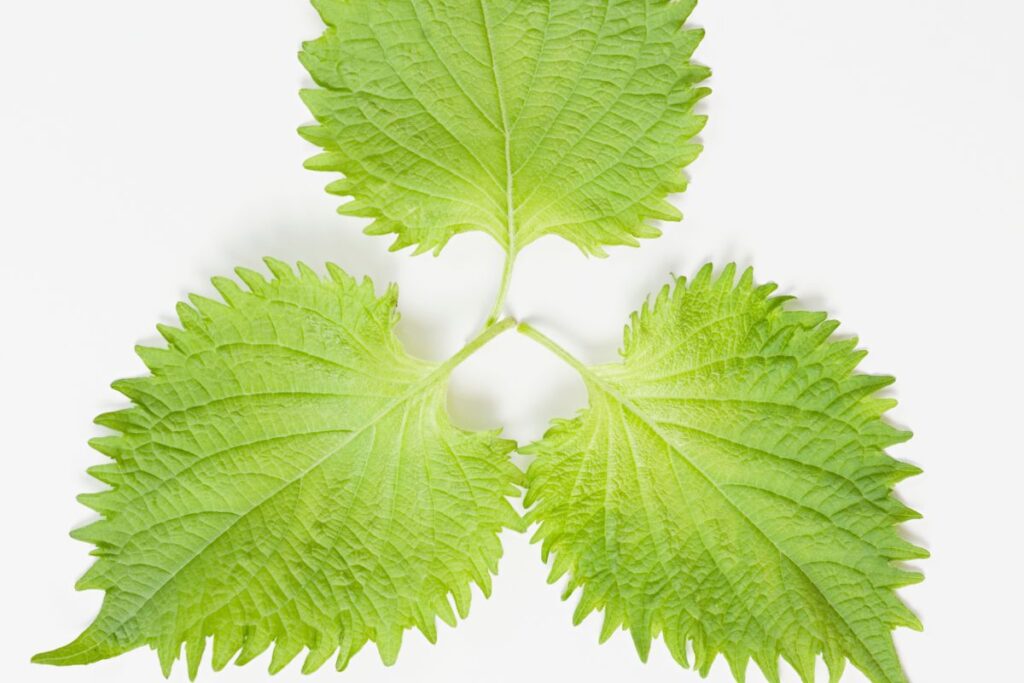Shiso is a versatile herb that holds a special place in Japanese cuisine. Its vibrant green leaves and unique flavor add a fresh and aromatic touch to a wide variety of dishes.
From sushi and sashimi to salads and soups, shiso is used in numerous traditional Japanese recipes.
One of the most popular ways to enjoy shiso is by wrapping it around a piece of sushi or sashimi. The herb’s slightly spicy and minty flavor complements the delicate taste of raw fish, creating a harmonious combination of flavors.
In addition to its taste, shiso’s bright green color adds an appealing visual element to the dish.
Shiso is also commonly used in salads, where its refreshing taste and crisp texture enhance the overall dish.
Whether it’s mixed with other vegetables or served as a garnish, shiso adds a vibrant and invigorating element to salads. Its flavor pairs particularly well with citrusy dressings or soy-based vinaigrettes.
In Japanese soups, shiso is often added as a finishing touch. Its aromatic qualities help to balance out the flavors of the soup and add a subtle herbal note to the dish. Whether it’s a miso soup or a clear broth, a few torn shiso leaves on top can make all the difference.
Overall, shiso is an herb that brings enchantment to Japanese cuisine. Its versatility and unique flavor make it a staple ingredient in many traditional dishes.
Whether it’s wrapped around sushi, tossed in a salad, or added to a soup, shiso adds a fresh and aromatic touch that transforms the overall dining experience.

Origins and History of Shiso
Tracing back to the mountains of China and India, shiso first sprouted into Japanese cuisine centuries ago. You’re diving into a history rich with cultural exchange and culinary innovation.
This herb, with its distinctive flavor and vibrant color, didn’t just stumble upon Japan. It was sought after, cultivated, and eventually embedded in the fabric of Japanese gastronomy.
You’ve got to understand, the journey of shiso wasn’t a straightforward path. It was a testament to the meticulous care and attention to detail that defines Japanese culture.
As you wield shiso in your culinary creations, you’re not just using an herb. You’re wielding a piece of history, a fragment of a centuries-old tradition that traveled vast distances to find its place in Japan.
Harnessing shiso in your dishes gives you control over an element that has shaped Japanese cuisine. You’re not just cooking; you’re curating an experience that bridges the past and present.
So, as you sprinkle that shiso, remember its journey. You’re part of a lineage of culinary enthusiasts who’ve recognized its value, a tradition that you now have the power to perpetuate.
Cultivation Tips
After exploring the rich history and journey of shiso, it’s time to learn how you can cultivate this vibrant herb in your own garden.
First, choose a sunny spot; shiso thrives in well-drained soil with ample sunlight. You’ll want to ensure the area gets at least six hours of direct sun daily.
Begin with seeds or seedlings, planting them about a quarter-inch deep in the soil. Space them out to give each plant room to grow—about 18 inches apart should do the trick. Shiso isn’t too picky, but it does prefer a slightly acidic to neutral soil pH, around 5.5 to 7.5.
Watering is crucial, especially in the early stages. Keep the soil consistently moist but not waterlogged. As your shiso plants mature, they’ll become more drought-tolerant, but don’t let them dry out completely.
To encourage bushier growth, pinch off the tops once the plants are about 8 inches tall. This will stimulate more leaves, which is exactly what you’re after.
Culinary Uses of Shiso
Shiso’s vibrant leaves and distinct flavor make it a versatile ingredient in a variety of Japanese dishes. You’ll find it elevates the taste of your meals beyond the ordinary, whether you’re garnishing, flavoring, or coloring.
Take control of your culinary creations by incorporating shiso in both traditional and innovative ways.
For starters, wrap shiso leaves around sushi or sashimi for an aromatic twist. You’ll appreciate how its minty, slightly spicy flavor complements the freshness of the fish.
If you’re crafting salads, tear shiso leaves into the mix. They’ll add a unique zest that sets your greens apart.
Don’t stop there. Use shiso as a natural coloring agent in pickles, giving them a striking hue and an appetizing tang. When you’re experimenting with marinades, infuse them with shiso to imbue meats with its distinctive essence.
This approach turns ordinary dishes into culinary masterpieces that you command.

Health Benefits
Beyond enhancing your dishes with its vibrant flavor and color, shiso also offers a range of health benefits that can bolster your well-being.
You’ll find that incorporating this potent herb into your diet isn’t just about elevating culinary creations—it’s also about taking control of your health.
Shiso is rich in vitamins A, C, and K, crucial for maintaining your vision, immune system, and bone health, respectively. You’re not just adding a splash of color to your meals; you’re fortifying your body’s defenses against diseases and aging.
Moreover, its anti-inflammatory properties can help you manage symptoms of allergies and asthma, giving you the upper hand against seasonal discomforts.
The herb’s rosmarinic acid content is another game-changer, offering antioxidant benefits that can protect your cells from damage and reduce your risk of chronic diseases. You’re essentially equipping your body with a shield against environmental stressors.
Incorporating shiso into your diet also supports your digestive health, thanks to its dietary fiber. You’re not only enhancing flavors but also ensuring that your digestive system runs smoothly, keeping you in control of your body’s internal processes. With shiso, you’re taking a proactive step towards a healthier, more vibrant life.
Pairing Ideas
Diving into the world of shiso pairings can unlock a treasure trove of flavors for your meals, elevating them from good to unforgettable.
You’ve got the power to transform your dishes with this versatile herb, so let’s explore some dynamic combinations that’ll leave your taste buds craving more.
Start by incorporating shiso into your seafood dishes. Its minty, slightly spicy flavor complements the richness of salmon or tuna perfectly. Imagine a salmon fillet wrapped in shiso leaves and grilled, or a tuna poke where shiso adds a fresh, aromatic touch.
Don’t stop there. Shiso makes a fantastic addition to salads and dressings. Toss it into a mixed green salad with a sesame dressing for a refreshing twist. Its unique flavor cuts through the fat of dressings, bringing balance and a pop of color.
For a truly controlled culinary experiment, mix shiso into your cocktails or mocktails. A shiso mojito or a shiso-infused lemonade showcases its versatility beyond the plate, proving it’s a powerhouse in both savory and sweet contexts.
Conclusion
Now you’ve got the scoop on shiso, from its rich origins to how it can transform your meals with a splash of color and a burst of flavor.
Whether you’re growing it in your garden or sprinkling it over your favorite dish, this versatile herb not only elevates your cooking but also packs a punch of health benefits.
However, we understand that not everyone may be a fan of the strong taste and unique aroma of shiso.
Have you tried shiso in your cooking? What’re your thoughts? Leave a comment and let’s know your experience with this vibrant herb.





Konnichiwa! (Hello!) I'm Pat Tokuyama, a Japanese tofu cookbook author, who travels for music, food, and adventure. If you like Japanese tea, checkout some of the newestorganic japanese tea, matcha bowls and noren and more!
** Curious about the Plant Based Japanese Cooking Club? ** Learn more here!